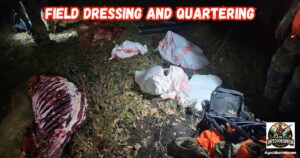Contents
- 1 Understanding Animal Behavior and Habitats
- 2 Essential Gear for Tracking Game Animals
- 3 Decoding Animal Tracks and Sign
- 4 Step-by-Step Guide to Tracking Game Animals
- 5 Important Considerations Before Heading Out
- 6 Advanced Tracking Tips and Tricks
- 7 How Beginners Benefit From the Right Tracking Equipment
- 8 Frequently Asked Questions
- 9 Game Animals are Where You Find Them
Tracking game animals is a hands-on skill I’ve found challenging and rewarding. It means using all my senses and patience to read the landscape and get a sense of animal movements. Learning how to track well can make outdoor experiences more interesting and often leads to successful wildlife observation or hunting. Let’s dig into the nitty-gritty and check out some practical tips for anyone wanting to step up their tracking game.
QUICK LOOK: 6 Tips for Tracking Game Animals
- Start scanning the area: I try not to keep my eyes glued to the ground. Instead, I scan ahead and around for broken branches, trails, or movement.
- Move quietly and steadily: Slow steps and careful footing help avoid snapping twigs or making noise.
- Mark up significant clues: When I stumble upon fresh sign like a clean track or a blood drop, I mark it mentally or with tape so I can circle back if I lose the trail.
- Read the gait: Track patterns help me know if the animal was walking or running, and whether it felt relaxed or spooked.
- Use all five senses: Listening for snaps, picking up scents, or feeling a recently warm bedding spot can reveal what’s around, even if sign is faint.
- If I lose the trail, grid search: Moving back and forth around the last clear sign, sometimes crawling, helps pick up the line again.
Understanding Animal Behavior and Habitats
My first step when tracking any game animal is to get familiar with their behavior and habits. Each species shows its own quirks and set patterns for seeking food, water, shelter, and choosing travel routes.
For example, deer generally travel along forest edges and slip through thick brush for cover, while turkeys pick open woodlands rich in ground foods. Studying animal field guides and learning from experienced trackers made it easier for me to spot where animals are likely hanging out.
Getting a lay of the land is just as crucial. Game animals use terrain features such as ridges, valleys, and waterways, and often stick to trails that follow the path of least resistance. If I can pick out natural funnels or corridors, I know where to start searching first. Animals rely on habit, and with enough repeated observations, I begin to see patterns pop up.
Essential Gear for Tracking Game Animals
Bringing along practical gear gives my efforts a big boost and keeps me comfortable in different weather or terrain. My footwear must be quiet and supportive so I can move over branches, grass, and rocks without making noise. A reliable map, compass, or GPS unit is key to mark trail signs and to keep myself from getting turned around, especially in unfamiliar places.
Binoculars are great for spotting wildlife or sign from a distance without spooking them. Trail cameras can help me check out animal activity in a spot before deciding to track up close. I always bring a weather-resistant notebook so I can log details and sketch out tracks or unique sign that might help later.
Decoding Animal Tracks and Sign
Reading tracks is where I started. A track’s size, shape, and depth tell a lot about which animal passed by, when, and what it was up to. For instance, deer prints have two pointed toes in a split-heart pattern, while coyotes’ paw prints are oval with claw marks. Spotting the difference between fresh tracks with clearer edges and older prints faded by weather is important for knowing if I’m following close.
There are other clues animals leave behind:
- Scat: Droppings show what an animal’s been eating and give clues on how recently it was there. Fresh scat is moist and dark. Older scat is faded and crumbly.
- Feeding signs: Signs of gnawed twigs, stripped bark, and chewed leaves can identify the species and how recently it fed there.
- Rubs and scrapes: Deer rub antlers on trees, and both deer and elk scrape the ground to mark territory.
- Hair and feathers: If I find hair or feathers on fences or branches, matching the color or length to a species gives a clearer idea of what I’m tracking.
- Bedding areas: Flattened grass or leaves in a hidden spot often means a recent resting site.
Being able to spot these signs lets me piece together a story of where an animal went, its actions, and whether it might still be nearby.
Step-by-Step Guide to Tracking Game Animals
- Start scanning the area: I try not to keep my eyes glued to the ground. Instead, I scan ahead and around for broken branches, trails, or movement.
- Move quietly and steadily: Slow steps and careful footing help avoid snapping twigs or making noise.
- Mark up significant clues: When I stumble upon fresh sign like a clean track or a blood drop, I mark it mentally or with tape so I can circle back if I lose the trail.
- Read the gait: Track patterns help me know if the animal was walking or running, and whether it felt relaxed or spooked.
- Use all five senses: Listening for snaps, picking up scents, or feeling a recently warm bedding spot can reveal what’s around, even if sign is faint.
- If I lose the trail, grid search: Moving back and forth around the last clear sign, sometimes crawling, helps pick up the line again.
With practice, these habits make me a sharper tracker who’s always tuned in to the smallest signs.
Important Considerations Before Heading Out
Planning makes every tracking adventure more enjoyable. I look at the weather and wear moisture-wicking layers to handle temperature changes, since I might spend hours glassing or crawling. I keep plenty of water and snacks handy so I don’t lose focus during long outings.
It’s also important to keep local laws and land access in mind. Some areas allow or limit the use of dogs for tracking, so I double-check regulations before heading out. Respecting boundaries and common hunting rules ensures everyone’s access is protected for the future.
Footwear and Clothing
Camo or earthtone gear helps me blend into my surroundings and avoid alerting wildlife. My boots should be quiet on any ground type, and I rely on breathable, warm socks to keep blisters away during long days.
I’ve learned it’s easy to get mixed up in dense woods. A map, compass, or GPS always comes with me, even if I know the area. Telling someone about my plans before I leave means someone always knows when to expect me back home.
Advanced Tracking Tips and Tricks
After understanding the basics, I work on improving my sensory awareness. Tuning out background noises and focusing helps me hear subtle animal sounds. Watching the wind is also key, as it prevents my scent from alerting deer and elk with their strong noses. I try to approach with the wind in my face, keeping my scent behind me.
Using game cameras gives me inside info on animal routines before I even head out. Looking over camera footage shows me the best times to track, usually around sunrise or sunset, when animals are most active.
After a successful shot, patience becomes vital. I wait before taking up a blood trail, carefully mark where the animal stood, and look closely for every drop or disturbed leaf. Remaining steady rather than rushing can mean a quicker and more ethical recovery.
How Beginners Benefit From the Right Tracking Equipment
Having proper tracking tools boosts both learning and results. Quality binoculars allow me to notice distant movements, while trail cameras show me hidden animal routines. I once found out through camera footage that deer were using the same route every night for several days, which turned out to be a goldmine for planning successful sits.
- Game Observation: Optics are great for keeping animals in view without getting too close.
- Hunting: Silent gear and good clothing let me get in tight for the cleanest shot.
- Wildlife Photography: Reading sign means I can set up for the perfect photo.
Tracking in the real world is slow and deliberate. The right gear and a patience-first attitude add up to lots of rewarding days and new lessons in the wild.
Frequently Asked Questions
Here are some questions folks often ask about tracking game animals:
What’s the best way to learn animal tracking?
Start with field guides and practice in local parks or woods. Watching animals and reading their sign under different conditions will build your skills naturally.
How do I know if a track is fresh?
Fresh tracks are sharp-edged and sometimes a bit moist. Older ones look dried out or filled with debris.
Are tracking techniques the same for all animals?
Animals all have unique tracks, sign, and routines. Taking time to learn each species helps you find them more reliably.
Game Animals are Where You Find Them
Wrapping up, tracking game animals comes down to a mix of knowledge, practice, and staying sharp with observation. With the right mindset and equipment, anyone can sharpen their skills at reading sign and make the most of everything the outdoors has to offer.
Most Recent Articles:
- Complete Guide On Tracking Game Animals

- DIY 4-Step Guide To Field Dressing And Quartering A Deer

- Night Vision Binoculars For Nocturnal Hunting

- The Science Behind Camouflage Patterns For Deer Hunting

- Binocular Accessories For Hunters

- 9 Tips for Using Trail Cameras To Track Deer Movements

As always, stay safe, enjoy the journey, and please try to leave it cleaner than you found it. If you have any comments, questions, ideas, or suggestions, please leave them in the comment section below, and I’ll get back to you ASAP. You can follow us on YouTube: Man Art Creations for videos of our DIY Adventures.
P.S. Thanks so much for checking out our blog; we really appreciate it. Just so you know, we may receive a commission if you click on some of the links that appear on our site. This helps us keep our content free and up-to-date for everyone. We appreciate your support!


